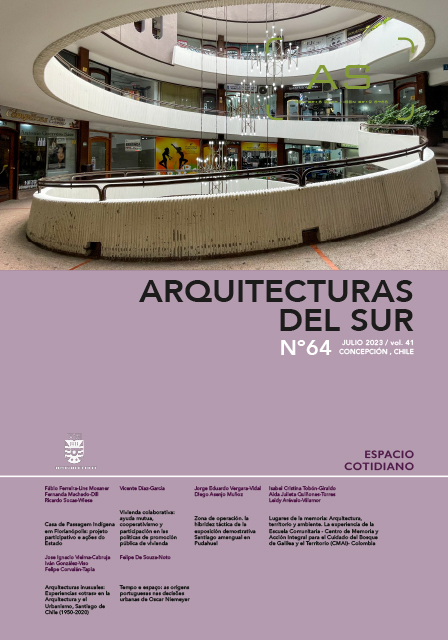Zona de Operación. La hibridez táctica de la exposición demostrativa Santiago Amengual en Pudahuel, Chile
DOI:
https://doi.org/10.22320/07196466.2023.41.064.03Palabras clave:
conjuntos residenciales, corporación de la vivienda, vivienda experimental, empresas constructoras, tipologíasResumen
La Exposición Demostrativa de Viviendas fue uno de los últimos concursos convocados por la Corporación de la Vivienda (CORVI) antes de su disolución en 1976 y, a su vez, uno de los primeros proyectos gestionados por su sucesor, el Servicio de Vivienda y Urbanización (SERVIU). Marcada por la necesidad de la dictadura cívico militar de responder a una exigida demanda de viviendas, fue empleada por sus funcionarios para explorar un modelo donde las empresas constructoras asumieran el conjunto de los procesos involucrados en esa industria. Ello se implementó en un pequeño sector de ocho cuadras de la Población Santiago Amengual mediante un concurso que licitó la construcción de nueve tipologías CORVI y el desarrollo de ciento cincuenta y seis tipos de viviendas pareadas y continuas de diferentes tamaño, disposición y técnicas de construcción. Utilizando información de documentos recopilados en dos investigaciones asociadas al tema y contrastada con observaciones etnográficas realizadas durante 2022 y 2023 en el mismo emplazamiento, fue posible identificar las diferentes ideas de proyecto explorados para el conjunto de la Población Santiago Amengual, determinar variaciones en su coherencia e identificar al concurso de la Exposición Demostrativa como una forma de zona de operación, abiertamente dispuesta a la evaluación y especulación sobre el comportamiento y desempeño de los modelos, técnicas y materialidades empleados en ella. La información analizada también permite proponer que dicha zona de operación facilitó la instalación de una nueva relación jerárquica entre las prácticas de arquitectura y construcción, en particular, las asociadas al conocimiento técnico y al capital y que, en tal sentido, su extrema heterogeneidad mostraba la disposición táctica de promover las convenciones de competencia y prácticas de producción adecuadas a dicho cambio y a la instalación un mercado de vivienda de interés social sin participación estatal.
Descargas
Citas
AUCA (2020). Amengual una experiencia. AUCA: Arquitectura Urbanismo Construcción Arte, (31): 27-48. Recuperado de: https://revistaauca.uchile.cl/index.php/AUCA/article/view/59506/62955
BARRIENTOS-DÍAZ, M. P., & NIETO-FERNÁNDEZ, E. J. (2021). Aprender a vivir con los otros a través del diseño. Comunidades de prácticas y saberes menores. Arquitecturas del Sur, 39(60), 62-77. DOI: https://doi.org/10.22320/07196466.2021.39.060.04
BRAVO HEITMANN, L. (1996). Vivienda social industrializada: la experiencia chilena (1960- 1995). Revista INVI, 11(28). DOI: https://doi.org/10.5354/0718-8358.1996.62055
CALLON, M., & RIP, A. (1991). Forums hybrides et négociations des normes sociotechniques dans le domaine de l’environnement. La fin des experts et l'irrésistible ascension de l’expertise. Environnement, Science et Politique. Cahiers du Germes, 13, 227-238.
Corporación de la Vivienda (CORVI) (1974). Densificación. Una estrategia para la economía del suelo urbano. Sub-Departamento de Diseño (CORVI).
COVACEVICH, J. (2020). Encuentro hoy arquitecto Chile. Auca: Arquitectura Urbanismo Construcción Arte, (35), 3. Recuperado de: https://revistas.uchile.cl/index.php/AUCA/article/view/59621
DE LA FUENTE, M. (1976). Edificio Bien Mueble. Modularq XXI. Revista del Colegio de Arquitectos, 17, 20-22.
GRANIFO, C., AHLERS, C., BRAVO, L., BECERRA, E., CÁRDENAS, J., DEPETRIS, O., HERNÁNDEZ, A., LABBÉ, E., & NEIRA, C. (2020). Amengual una encuesta. Auca: Arquitectura Urbanismo Construcción Arte, (31), 49-59. Recuperado de: https://rchd.uchile.cl/index.php/AUCA/article/view/59507
LAW, J. (2002). Aircraft Stories. Duke University Press.
LAW, J., & JOKS, S. (2019). Indigeneity, Science, and Difference: Notes on the Politics of How. Science, Technology, & Human Values, 44(3), 424-447. DOI: https://doi.org/10.1177/0162243918793942
Ministerio de Vivienda (MINVU) (1976a). Exposición Demostrativa Santiago Amengual. Una experiencia en Vivienda Social. División Técnica de Estudios y Fomento Habitacional, MINVU.
Ministerio de Vivienda (MINVU) (1976b). Exposición Demostrativa Santiago Amengual. Terrenos de la Población "General Santiago ex Santa Corina. División Técnica de Estudios y Fomento Habitacional, MINVU.
PETERMANN, A. (2006). ¿Quién extendió a Santiago? Una breve historia del límite urbano, 1953-1994. Alexander Galetovic (Ed.). Santiago. Dónde estamos y hacia dónde vamos. 205-230. CEP.
RAPOSO, A. (2009). Vivienda Social. La obsolescencia de las máquinas de regulación social. Revista de diseño urbano y paisaje, 6(18), 1-85. Recuperado de: http://dup.ucentral.cl/pdf/18_vivienda_social.pdf
SCHUTZ, A. & LUCKMANN, T. (2009). Las estructuras del mundo de la vida. Amorrortu.
STAR, S. L., & RUHLEDER, K. (1996). Steps Toward an Ecology of Infrastructure: Design and Access for Large Information Spaces. Information Systems Research, 7(1), 111–134. DOI: http://doi.org/10.1287/isre.7.1.111
VERGARA VIDAL, J. E., ÁLVAREZ CAMPOS, D., ASENJO MUÑOZ, D., & DINTRANS BAUER, D. (2021). Practicidad y comunicación de lo técnico en las tipologías de vivienda CORVI. Revista INVI, 36 (103), 323-348. Recuperado de: https://revistainvi.uchile.cl/index.php/INVI/article/view/63417
VERGARA-VIDAL, J. E., ÁLVAREZ CAMPOS, D., ASENJO MUÑOZ, D., & DINTRANS BAUER, D. (2022). Valores pragmáticos. La operación de la practicidad y la coherencia en la vivienda racionalizada CORVI. Revista De Arquitectura, 27(42), 110–125. https://doi.org/10.5354/0719-5427.2022.66414
VICUÑA DEL RÍO, M. (2020). Densidad y sus efectos en la transformación espacial de la ciudad contemporánea: cinco tipologías para interpretar la densificación residencial intensiva en el área metropolitana de Santiago. Revista 180, (45), 112-126. DOI: https://dx.doi.org/10.32995/rev180.num-45.(2020).art-659
Descargas
Publicado
Cómo citar
Número
Sección
Licencia
Derechos de autor 2023 Jorge Eduardo Vergara-Vidal, Diego Asenjo-Muñoz

Esta obra está bajo una licencia internacional Creative Commons Atribución-CompartirIgual 4.0.
El contenido de los artículos que se publican en cada número de Arquitecturas del Sur, es responsabilidad exclusiva de los autores y no representan necesariamente el pensamiento, ni comprometen la opinión de la Universidad del Bío-Bío.
Las/os autoras/es conservarán sus derechos de autoría, sin embargo, garantizarán a la revista el derecho de primera publicación y difusión de su obra. La publicación del artículo en Arquitecturas del Sur está sujeta a la Licencia de Reconocimiento de Creative Commons CC BY-SA que permite a otros Adaptar: remezclar, transformar y construir sobre el material para cualquier propósito, incluso comercialmente, Compartir: copie y redistribuya el material en cualquier medio o formato, siempre y cuando se reconozcan la autoría y la primera publicación en esta revista citando correctamente, así como también sus nuevas creaciones estén bajo una licencia con los mismos términos.













 Programa de Información Científica/Concurso Fondos de Publicación de Revistas Científicas 2018/ Proyecto Mejoramiento de Visibilidad de Revistas UBB (Código:FP180007)
Programa de Información Científica/Concurso Fondos de Publicación de Revistas Científicas 2018/ Proyecto Mejoramiento de Visibilidad de Revistas UBB (Código:FP180007) 
